 The
"Miracle" variety, which was developed by Bernardo O. Dizon,
has proven itself as one of a few grape varieties suited to
Philippine conditions. The
"Miracle" variety, which was developed by Bernardo O. Dizon,
has proven itself as one of a few grape varieties suited to
Philippine conditions.
In fact, said Dizon, the "Miracle grape" should perform very
well in many areas where the dry season is long and there is
plenty of sunshine available.
For
those who are interested in joining the growing ranks of
"Miracle grape" grower, here are the details of Dizon's
"Miracle grape" technology.
CLIMATE
Grapes
grow well in warm, sunny and dry climate. Areas with more
than four dry months are good for grapes. Grapes grow fast
when there is alternate rain and sunshine but the fruiting
should coincide in drier months to have quality fruits.
PLANTING SEASON
Grapes
can be planted any time of the year. However, in the
Philippines, the best time for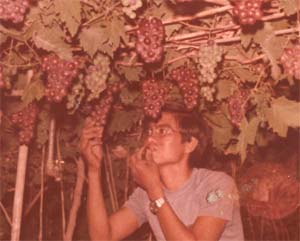 planting is during the early
and mid summer months. Grape seedling will grow vigorously
during this period due to the absence of rain. Newly planted
grapes lack resistance to diseases brought about by
continuous rain especially when they are not sprayed with
chemical to combat the diseases planting is during the early
and mid summer months. Grape seedling will grow vigorously
during this period due to the absence of rain. Newly planted
grapes lack resistance to diseases brought about by
continuous rain especially when they are not sprayed with
chemical to combat the diseases
SOIL
Soil
requirements are not exacting. Moderately fertile
well-drained heavy or light soil all produce good crops.
Clayey as well as sandy soil are also suitable for planting
grapes. Mix compost or animal dung to improve texture on
heavy soil. The soil must have sufficient depth and should
have soil acidity of pH 5.0 or more.
POPULATION
The
distance between rows and between plants in the rows depend
upon the convenience of the grower, shape of the area, type
of culture and the implements to be used. With overhead
trellis, the vines should be planted at a distance of 2.5
meters between rows and two meters between plant. On "U"
type trellis it is recommended to use double row. The plants
are set at two by two meters and 2.5 meters between trellis.
Two thousand seedlings are needed to plant one hectare. This
is to maximize production during the first five years. After
three to five years the population can be thinned. The extra
vines can be transferred to another area by means of bolling
or marcotting.
 LAND PREPARATION AND
PLANTING LAND PREPARATION AND
PLANTING
Soil
is prepared in the same manner as when planting vegetables.
A single plowing and two harrowings to pulverize the soil
and remove grasses and weeds is sufficient. Lay the furrows
on a North-South direction two to three metes apart to
insure that each plant receives sufficient sunlight.
Dig
each hole on foot square and one-and-a-half feet deep. Set
aside the or top soil and mix with compost or animal
dung. To give a good start and induce the roots to spread
downwards, put fertilizer at the bottom of the hole and
cover with about 10-12 inches of top soil. Put a stake which
will serve as support to the growing vine.
Place
the seedling at the middle of the hole and cover with the
topsoil mixed with compost or animal dung. Tie the vine
lightly to the stake and water the newly planted vine.
Before
placing the seedling in the prepared hole, remove entirely
the plastic or container to give complete freedom to the
roots. Take care not to break the soil to prevent damage to
the roots. If the seedling came from a far place and the
soil in the container is broken, wait for three or more days
before transplanting so that the seedling will have a chance
to regain its vigor.
TRELLIS
In the
Philippines, the grape bear fruit only at the apical portion
of the vine where it is pruned. A trellis is therefore
needed to support the increased number of fruiting canes.
The growth and production of the fruiting vines cannot be
induced without trellises.
There
are several types of trellises suitable for grapes. These
are the "T" or "U" type, overhead or arbor type, bush type
are fence type.
The
"U" or "T" type is a post with a horizontal bar. The trellis
is shoulder-high or five feet. On
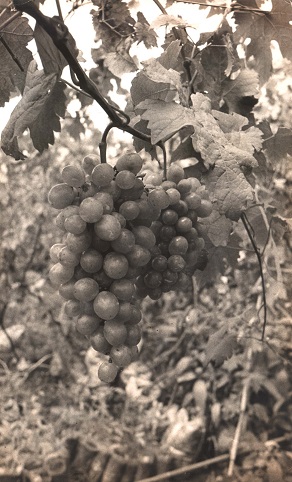 this cross piece, lay
strands of wire space ten inches apart towards the opposite
post. This type facilitates spraying. Moreover, the worker
can easily avoid getting wet with the chemicals. This type
also facilitates the training and fixing the vine to the
wires and other chores. It is sturdy and can resist typhoons
and strong winds. this cross piece, lay
strands of wire space ten inches apart towards the opposite
post. This type facilitates spraying. Moreover, the worker
can easily avoid getting wet with the chemicals. This type
also facilitates the training and fixing the vine to the
wires and other chores. It is sturdy and can resist typhoons
and strong winds.
The
"overhead or arbor" type is a continuous trellis, more than
six feet high. The problem with this type is that the worker
can easily get wet with the chemicals in spraying. He is
also likely to get tired, easily thereby slowing down the
work.
The
"bush type" is a single post placed beside the grape vine.
This is adapted to the temperate countries where almost all
the nodes of the grape plant from the bottom to the end bear
fruit. This type is not suitable in the Philippines. This is
because of the difference in the manner in which the grapes
bear fruits.
The
"fence type", as the same name implies, is like a fence.
Posts are erected between grape vines and three to five
strands of wire are strung as support for the vines. Grape
vines trained on this type of trellis produce limited
fruiting canes, unlike in the "T" type.
FERTILIZATION
Like
any living thing grapes vines need a balanced diet to have a
good growth, produce high yield and bear quality fruits.
Amount and kind of fertilizer depends on the texture of the
soil. Heavy soil like clay loam needs less fertilizer than
light or sandy soil. Clayey soils needs more nitrogen and
phosphorous while sandy soils need all the three essential
elements.
An adequate supply as well as the proper balance of the
essential nutrients (NPK) is particularly important. Of the
three essential nutrients, nitrogen (N) is the element that
is usually taken in large quantities. It has the greatest
influence on shoots, leaf formation and yield. Nitrogen
deficiency normally results in stunted growth, and small,
pale leaves which shed prematurely. An excess of Nitrogen,
however, has the one-side effect of promoting leaf
development while the wood and the fruit fail to ripen
properly and become more sensitive to fungus disease attack.
Phosphorous (P) promotes a strong, deep root system and
healthy growth with better ripening of the shoot and fruit.
Phosphorous deficiency makes the leaves bluish green with a
dull purple tint at the edges. The shoots become small in
size, thin and straight.
An ample supply of potassium (K) not only helps maintain a
high yield but also improves quality. Potassium helps ensure
large cluster of plump, evenly ripe berries, increase sugar
content. Potassium deficiency cause marginal and interveinal
chlorosis on the leaves, poor setting of berries,
pre-harvest fruit shattering, uneven ripening.
Other
trace elements can be supplied thru organic fertilization
and foliar spray.
To assess the right nutrient balance for proper shoot and
fruit development have the soil analyzed by the Bureau of
Soil. TRAINING
The
number and size of cluster specially during the first year
greatly depend on the training and production of the vine.
In temperate countries, where the bush type of culture is
extensively practiced, the buds invariably produce flowers.
In the tropics like the Philippines, however, flowers appear
only on the nodes at the end of the vine where it is cut.
That is why training and multiplication of the vine is very
important to ensure the success of a grape production
project.
After planting the seedling, drive a straight stake beside
it to support the vine as it grows upward towards the
trellis. Only one shoot (vine) should be allowed to survive.
Select the healthiest shoot and cut off all the rest. All
the growing hormones will go to this vine insuring its
vigorous and healthy growth.
Disbud
the secondary shoots up to four inches below the trellis. Do
not remove the leaves. Tie lightly the vine to the stake
with banana stalk or straw. Do not use wire, plastic or
abaca as these will likely damage the vine. A slight
tightening might break or cut the plant.
It is
necessary to tie the vine to the stake because its tendrils
are not yet present at the early stage of its life. Keep the
vine straight until it reaches the trellis. The plant will
eventually develop into a woody tissue like a tree and the
stake will no longer necessary.
As the
vine reaches the trellis, pinch off the tip to encourage the
growth of secondary shoots or branches. From the point where
the tips were pinched off, allow from four to six branches
to grow over the trellis. When these branches reach a length
of one foot, pinch the tips again to allow the growth or
development of from two to four secondary branches from each
branch. Do not cut or prune any branch from the original
secondary branches.
As this stage there will be ten to eighteen big branches.
When these 10 to 18 branches are one foot long pinch again
the tips to enable the growth of from two to four other
branches. At this point, there will be 40 to 50 branches
which will be allowed to grow and bear fruit (fruiting
cane). If all the above steps are observed properly, each
growing cane may be expected to produce a bunch or cluster
of grapes. IRRIGATION
Water is
a very important requirement of grapes. Moist soil during
the summer month especially at pruning time is very
necessary.
Irrigation may be done by allowing the water to flow along
the canal between the plant rows or by the sprinkler system.
If flowing water is not available, manual watering may be
resorted to.
Another thing to consider is weeding. Weeds can be prevented
to grow through mulching with rice straw, sawdust and other
materials. Besides, the mulched materials serve as
fertilizer and prevent the compaction of the soil.
Do not
irrigate three to four weeks on clayey soil and two weeks on
a sandy soil before harvesting to make fruits sweeter.
WEEDING AND CULTIVATION
The soil
should be loose and porous so that the roots will have
sufficient air and absorb water easily. When ploughs and
other mechanical tools are used, shallow cultivation is
preferred to prevent injury to the roots. Grasses and weeds
should be removed as these compete for space and serve as
breeding places for destructive insects and pests.
Do not
hill-up the base. It will only serve as devilling for soil
insects and a hindrance in the distribution of water and
fertilizer. PESTS
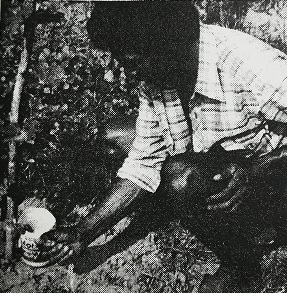 Pests and
diseases are a contributory factor in the failure of early
grape planters. Grapes will be defoliated and young buds
will die within a very short time unless pests and disease
are readily controlled and arrested. Pests and
diseases are a contributory factor in the failure of early
grape planters. Grapes will be defoliated and young buds
will die within a very short time unless pests and disease
are readily controlled and arrested.
The plant
will not die as a result of these pests and diseases,
because they will grow again once the pests or diseases have
gone. But the vine will need time to recover. As a result,
fruiting may occur only once a year, or maybe not at all.
Attack of
pests and diseases usually occur in different season. Pest
normally appear during the summer months while diseases
attack during rainy season. If the chemicals and method of
application are not appropriate the pests and diseases may
be controlled.
There are different pests, some of them can not be seen by
the eyes (microsc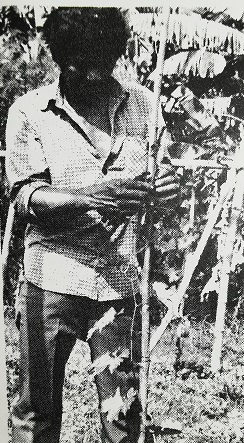 opic). Tiny and microscopic pests can cause
heavy damage before the planter discovers their existence.
By the time, it will be too late to control the pests and
save the crops. opic). Tiny and microscopic pests can cause
heavy damage before the planter discovers their existence.
By the time, it will be too late to control the pests and
save the crops.
Among these tiny and microscopic pests are the "nematodes"
which thrive in the soil and damage the roots. Then, there
are the "mites" which thrive and destroy the leaves.
Nematodes are microscopic - a few grams of soil may contain
thousands or even millions which destroy the plant or causes
it to develop "fanlead". If the soil is heavily infested
with nematodes, the grape will become stunted, the leaves
will shrink and assume the shape of a fan, hence the term "fanleaf."
To be
sure, that this type of pest will not attack the grapes,
have the soil examined by the proper agencies. Get samples
of the soil right where the grapes are planted and send them
for examination and analysis to the Plant-Pathologist of the
Bureau of Plant Industry (BPI) or to the Plant Pathology
Department of the University of the Philippines, College of
Agriculture in Los Banos, Laguna. Fortunately, the nematodes
problem has not been experienced in the Philippines although
it is prevalent in other countries.
Another
pest that can inflict heavy damage to the plant before it is
discovered is the "mite". This pest usually thrives and
causes damage to the vine during the summer months only.
This is not a problem during the rainy season. The mites
resembles the spider but is so small that unless one looks
closely at the leaf, the presence of this pest cannot be
detected.
The mite is a red insect that sucks the sap of a leaf until
it dries up. The best time to prevent or control this pest
is during the onset of the dry season. Spray the leaves with
"acaricide" or "miticide" at seven to 10 days interval. This
can be mixed with other chemicals.
Other
insects that attack grapes are the aphids, scale ants and
leaf hopper that suck the sap of the grape through the
leaves, branches and buds. Insects that destroy by eating
the leaves, buds, flowers and fruits are larvae, beetles,
etc. Grubs termites and ants destroy the plant by attacking
the roots.
These insects pests can easily be controlled by spraying
with "ordinary insecticides". If the soil is heavily
infested with ants or termites, the use of proper chemicals
in granulated will stay longer in the soil. Never hill-up or
cover the base of the plant with more soil than is necessary
because this will only serve as dwelling place for ants and
termites. DISEASES
In the
Philippines, Downy mildew and anthracnose are the prevalent
diseases during the rainy season. These diseases are very
rare during the dry season. The humid condition brought
about by the rains encourage the appearance and spread of
these diseases. A mildew attack is characterized by a white
mold covering the underleaf. This results in the drying up
and falling off the leaf. The branches will also dry up and
die.
The anthracnose or bird-eye rot are black spots present on
the leaves, branches and shoots that cause it to dry up and
die.
Other diseases that attack grapes are the rust, black rot,
fan leaf and scrab. All these diseases can easily be
controlled if the appropriate chemicals are used and the
proper method of application is observed. "Mancozeb" is one
of the most effective chemicals for combating downy mildew,
anthracnose and other diseases.
In
spraying, the under and upper surfaces of the leaves should
be thoroughly wet with the chemical, including the branches
down to the base of the plant. This will insure that the
affected parts are reached. Spray the grape at seven to 10
days interval. During the rainy season, spray after each
heavy rain.
Study what pest or diseases attack the plant for each season
so that the only appropriate chemicals will be used thus
avoiding unnecessary expenses.
PRUNING
Unlike
other plats, grapes do not have fixed season for bearing
fruit. The grape can be made to bear fruit depending on the
desire of the planter. Harvesting and marketing is,
therefore, not a problem.
If the
plantation is big, divide it into two or more parts and
prune each part at a time. This way, harvesting will not
take place at all once. The planter may not be able to
dispose off a big harvest and the fruits may rot.
Furthermore, a glutted market may depress prices.
General
pruning is done when the vine is at least eight months to
one year old provided the vines are of the right size and
have been tended properly. If care is inadequate, it will
take more than a year before the plants will bear fruit. The
best way to determine whether the grape is ready for pruning
is its growth and vigor. If the branches are pencil-size,
brown and there is no longer a sign of further growth, the
plant is ready for pruning.
Pruning
should be done at the onset of dry season. In Central Luzon
the first pruning may be done in November or December and
the harvesting will fall in January or February. The second
pruning can be done in March or April for harvests in May or
June.
Should be a third pruning be desired to catch the market for
December, pruning season in August and September. There is a
risk, however, because these months belong to the rainy
season. It is therefore necessary to provide protection for
the flowers and small fruits.
Under the
traditional method of growing grapes, there are two ordinary
methods of pruning. These are the "spur pruning" and the
"long cane pruning". Spur pruning is applicable to Red
Cardinal, Black Ribier, and other varieties. In this method,
only two to five buds will be left after cutting of the
matured pencil-sized branch. If the canes are small, leave
two nodes only because this will not bear fruit, and even if
it will the fruits will be very small. The ensuing branch
will be allowed to grow up to the next pruning season.
In the
long cane pruning, eight to 15 nodes will be left. The
varieties suitable under this method are the Malaga,
Concord, Brazilian Hybrid and Miracle grapes. All the
branches and leaves are removed with the use of pruning
shears except for the fruiting canes and small branches,
called replacement spurs, for the next pruning. After
pruning, the vine will be completely bare.
MODIFIED PRUNING
This
method was developed by Dizon. It is a combination of the
two methods plus some modification. When the vine is eight
months or one year old, prune or cut between the brown and
green portion of the pencil-size vine. Do not remove the
leaves if the plant is less then eight months old or there
are no brown vines on the trellis. From the cut portion, the
first two or three secondary buds or small shoots should be
removed leaving only the primary of fruiting bud. The small
secondary vine beyond the first three primary bud should be
cut to one node.
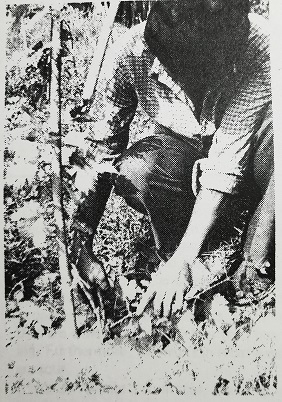 Within
two to three weeks, the bud will be developed and the
flowers will already be visible. Within
two to three weeks, the bud will be developed and the
flowers will already be visible.
In some
cases, pruning can be done only after four o six months from
date of planting. Under normal condition, the vines will
have 10 to 12 green and immature branches after four months.
To induce this to bear fruits (one-half to two kilos
per-vine) all these branches should be pruned or cut. Do not
remove the leaves. In this pruning technique, even less than
pencil-sized vines can be induced to fruit. However, the
branches will be small.
PRINCIPLE
There are
three growing points of the grape vine. First is the shoot
or growing vine which comes from the primary or secondary
bud. Along the nodes are the secondary and primary bud.
Secondary buds sprout as the vine grow. The last is the
primary bud or fruiting bud. The primary fruiting bud is
dormant and the vine does not bear fruits unless pruned.
Pruning results in the removal of two growing parts leaving
only the primary bud where flowers sprout. This is a
characteristic of locally grown grapes and is called Apical
dominance.
FRUIT-BEARING PERIOD
This is
the time when intensive care is needed to obtain more and
bigger clusters of fruit. Irrigation, fertilizer application
and spraying with chemical should be done regularly. If the
clusters are over crowded with fruit, remove the smaller
berries between the larger ones. In so doing the quality of
the grape will be improved and the clusters will be much
heavier.
There is
still another way to produce bigger and longer clusters.
This is by spraying the flowers with "chlorphenoxyacetic
acid", gibberlic acid", and other similar preparations.
Follow the instructions and recommendations of the
manufacturer. The use of these chemicals will result in
bigger and heavier fruit than when it is not sprayed at all.
A
Dizon-formulated hormone promotes seedless on miracle
variety if applied when the berries are pin-size. A pack
worth P15.00 can treat 50 kilos of grapes. Dizon said this
will increase fruit weight by 20 per cent and improve
quality. It can also treated in black and red varieties when
the berries are mongo-size.
HARVESTING
Grapes
are among a few fruits that do not ripen when picked or
harvested. It is therefore necessary to test the fruit for
ripeness before it is harvested. The best way to do this is
by testing a fruit from the tip of the bunch.
Another
way of determining the maturity of the fruits is by the
number of days from date of pruning. Red Cardinal ripen
after 85-100 days, Black Ribier, Brazilian hybrid, miracle,
white malaga mature after 110-130 days.
In
harvesting pick the fruits by cutting the stem of the
cluster with a pair of scissors or shears, taking care not
to drop or damage any of the berries. Put the clusters
carefully in baskets or in packing crates with fully dried
sawdust placed between clusters to prevent the berries from
being crushed by their own weight.
PROPAGATION
Grapes
can be propagated by means of seeds and cuttings.
Propagation by means of vegetative pars is more favorable.
Besides growing fast and bear fruit early, the plans also
bear the characteristics of the parent vines. On the other
hand, propagation by seeds results in vines that are slow
growing and later fruit bearing. Furthermore, the fruits is
most cases are sour.
In
temperate countries, budding or grafting is extensively
practiced. When budding or grafting, the point of union must
be well above the ground to prevent the development of scion
roots.
Marcotted
plants grow faster than rooted cuttings. Its setback
however, lies in the fact that the parent vine's fruit
production is greatly reduced and have a shorter life span.
Marcotting also is an expensive and time consuming endeavor.
The easiest and most popular method of propagation is by
means of cutting. |

